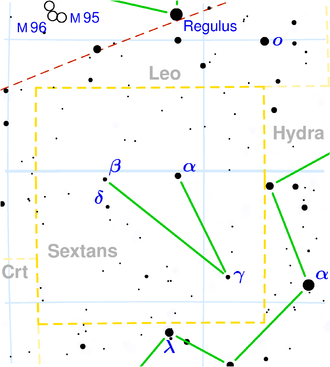NGC 2980
| Galaxy NGC 2980 |
|
|---|---|

|
|
| AladinLite | |
| Constellation | sextant |
|
Position equinox : J2000.0 , epoch : J2000.0 |
|
| Right ascension | 09 h 43 m 12.0 s |
| declination | -09 ° 36 ′ 45 ″ |
| Appearance | |
| Morphological type | SAB (s) c? / HII |
| Brightness (visual) | 13.0 likes |
| Brightness (B-band) | 13.7 mag |
| Angular expansion | 1.6 ′ × 0.8 ′ |
| Position angle | 164 ° |
| Surface brightness | 13.1 mag / arcmin² |
| Physical data | |
| Redshift | 0.019080 ± 0.000030 |
| Radial velocity | 5720 ± 9 km / s |
|
Stroke distance v rad / H 0 |
(248 ± 17) · 10 6 ly (75.9 ± 5.3) Mpc |
| history | |
| discovery | William Herschel |
| Discovery date | March 27, 1786 |
| Catalog names | |
| NGC 2980 • PGC 27799 • MCG -01-25-028 • IRAS 09407-0923 • 2MASX J09431196-0936446 • GC 632 • H III 528 • h 1908 • GALEX ASC J094311.98-093642.9 • HIPASS J0943-09a | |
NGC 2980 is a bar-spiral galaxy with extensive star formation regions of the Hubble type SBc in the constellation Sextant in the southern sky . It is estimated to be 248 million light years away from the Milky Way and has a diameter of about 120,000 ly.
In the same area of the sky there are u. a. the galaxies NGC 2978 and NGC 2979 .
The supernovae SN 2006ba (Type-IIb) and SN 2009lm (Type-IIP) were observed here.
The object was discovered on March 27, 1786 by the astronomer Wilhelm Herschel .
